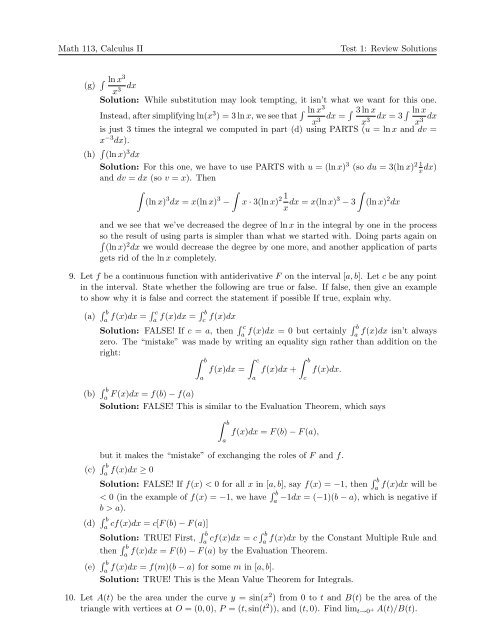Solutions to Practice Problems
Solutions to Practice Problems
Solutions to Practice Problems
Create successful ePaper yourself
Turn your PDF publications into a flip-book with our unique Google optimized e-Paper software.
Math 113, Calculus II<br />
Test 1: Review <strong>Solutions</strong><br />
(g) ∫ ln x 3<br />
dx<br />
x 3<br />
Solution: While substitution may look tempting, it isn’t what we want for this one.<br />
Instead, after simplifying ln(x 3 ) = 3 ln x, we see that ∫ ln x 3<br />
x 3 dx = ∫ 3 ln x<br />
x 3 dx = 3 ∫ ln x<br />
x 3 dx<br />
is just 3 times the integral we computed in part (d) using PARTS (u = ln x and dv =<br />
x −3 dx).<br />
(h) ∫ (ln x) 3 dx<br />
Solution: For this one, we have <strong>to</strong> use PARTS with u = (ln x) 3 (so du = 3(ln x) 2 1 x dx)<br />
and dv = dx (so v = x). Then<br />
∫<br />
∫<br />
(ln x) 3 dx = x(ln x) 3 −<br />
x · 3(ln x) 2 1 ∫<br />
x dx = x(ln x)3 − 3<br />
(ln x) 2 dx<br />
and we see that we’ve decreased the degree of ln x in the integral by one in the process<br />
so the result of using parts is simpler than what we started with. Doing parts again on<br />
∫<br />
(ln x) 2 dx we would decrease the degree by one more, and another application of parts<br />
gets rid of the ln x completely.<br />
9. Let f be a continuous function with antiderivative F on the interval [a, b]. Let c be any point<br />
in the interval. State whether the following are true or false. If false, then give an example<br />
<strong>to</strong> show why it is false and correct the statement if possible If true, explain why.<br />
(a) ∫ b<br />
a f(x)dx = ∫ c<br />
a f(x)dx = ∫ b<br />
c f(x)dx<br />
Solution: FALSE! If c = a, then ∫ c<br />
a f(x)dx = 0 but certainly ∫ b<br />
a<br />
f(x)dx isn’t always<br />
zero. The “mistake” was made by writing an equality sign rather than addition on the<br />
right:<br />
∫ b<br />
a<br />
f(x)dx =<br />
∫ c<br />
a<br />
f(x)dx +<br />
∫ b<br />
c<br />
f(x)dx.<br />
(b) ∫ b<br />
a<br />
F (x)dx = f(b) − f(a)<br />
Solution: FALSE! This is similar <strong>to</strong> the Evaluation Theorem, which says<br />
∫ b<br />
a<br />
f(x)dx = F (b) − F (a),<br />
but it makes the “mistake” of exchanging the roles of F and f.<br />
(c) ∫ b<br />
a f(x)dx ≥ 0<br />
Solution: FALSE! If f(x) < 0 for all x in [a, b], say f(x) = −1, then ∫ b<br />
a<br />
f(x)dx will be<br />
< 0 (in the example of f(x) = −1, we have ∫ b<br />
a<br />
−1dx = (−1)(b − a), which is negative if<br />
b > a).<br />
(d) ∫ b<br />
a<br />
cf(x)dx = c[F (b) − F (a)]<br />
Solution: TRUE! First, ∫ b<br />
then ∫ b<br />
a<br />
a cf(x)dx = c ∫ b<br />
a<br />
f(x)dx by the Constant Multiple Rule and<br />
f(x)dx = F (b) − F (a) by the Evaluation Theorem.<br />
(e) ∫ b<br />
a<br />
f(x)dx = f(m)(b − a) for some m in [a, b].<br />
Solution: TRUE! This is the Mean Value Theorem for Integrals.<br />
10. Let A(t) be the area under the curve y = sin(x 2 ) from 0 <strong>to</strong> t and B(t) be the area of the<br />
triangle with vertices at O = (0, 0), P = (t, sin(t 2 )), and (t, 0). Find lim t→0 + A(t)/B(t).
















